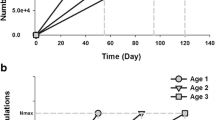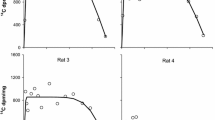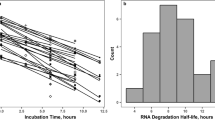Abstract
The lifespan of red blood cells (RBCs) plays an important role in the study and interpretation of various clinical conditions. Yet, confusion about the meanings of fundamental terms related to cell survival and their quantification still exists in the literature. To address these issues, we started from a compartmental model of RBC populations based on an arbitrary full lifespan distribution, carefully defined the residual lifespan, current age, and excess lifespan of the RBC population, and then derived the distributions of these parameters. For a set of residual survival data from biotin-labeled RBCs, we fit models based on Weibull, gamma, and lognormal distributions, using nonlinear mixed effects modeling and parametric bootstrapping. From the estimated Weibull, gamma, and lognormal parameters we computed the respective population mean full lifespans (95 % confidence interval): 115.60 (109.17–121.66), 116.71 (110.81–122.51), and 116.79 (111.23–122.75) days together with the standard deviations of the full lifespans: 24.77 (20.82–28.81), 24.30 (20.53–28.33), and 24.19 (20.43–27.73). We then estimated the 95th percentiles of the lifespan distributions (a surrogate for the maximum lifespan): 153.95 (150.02–158.36), 159.51 (155.09–164.00), and 160.40 (156.00–165.58) days, the mean current ages (or the mean residual lifespans): 60.45 (58.18–62.85), 60.82 (58.77–63.33), and 57.26 (54.33–60.61) days, and the residual half-lives: 57.97 (54.96–60.90), 58.36 (55.45–61.26), and 58.40 (55.62–61.37) days, for the Weibull, gamma, and lognormal models respectively. Corresponding estimates were obtained for the individual subjects. The three models provide equally excellent goodness-of-fit, reliable estimation, and physiologically plausible values of the directly interpretable RBC survival parameters.



Similar content being viewed by others
References
Ashby W (1921) The determination of the length of life of transfused blood corpuscles in man. J Exp Med 29:267–281
Krzyzanski W, Perez-Ruixo JJ, Vermeulen A (2008) Basic pharmacodynamic models for agents that alter the lifespan distribution of natural cells. J Pharmacokinet Pharmacodyn 35:349–377
Cohen RM, Franco RS, Khera PK, Smith EP, Lindsell CJ, Ciraolo PJ, Palascak MB, Joiner CH (2008) Red cell life span heterogeneity in hematologically normal people is sufficient to alter HbA1c. Blood 112(10):4284–4291
Ly J, Marticorena R, Donnelly S (2004) Red blood cell survival in chronic renal failure. Am J Kidney Dis 44(4):715–719
Vos FE, Schollum JB, Coulter CV, Doyle TC, Duffull SB, Walker RJ (2011) Red blood cell survival in long-term dialysis patients. Am J Kidney Dis 58:591–598
Banks HT, Bliss KM, Tran H (2012) Modeling red blood cell and iron dynamics in patients with chronic kidney disease. Int J Pure Appl Math 75
Franco RS (2009) The measurement and importance of red cell survival. Am J Hematol 84:109–114
Luten M, Roerdinkholder-Stoelwinder B, Schapp NPM, de Grip WJ, Bos HJ, Bosman GJCGM (2008) urvival of red blood cells after transfusion:a comparison between red cells concentrates of different storage periods. Transfusion 48(7):1478–1485
Lledó-García R, Kalicki RM, Uehlinger DE, Karlsson MO (2012) Modeling of red blood cell life-spans in hematologically normal populations. J Pharmacokinet Pharmacodyn 39(5):453–462
Callender ST, Powell EO, Witts LJ (1945) The lifespan of the red cell in man. J Pathol Bacteriol 57(1):129–139
International Committee for Standardization in Hematology (1980) Recommended method for radioisotopic red-cell survival studies. Br J Haematol 45:659–666
Kuruvilla DJ, Nalbant D, Widness JA, Veng-Pedersen P (2014) Mean remaining life span: a new clinically relevant parameter to assess the quality of transfused red blood cells. Transfusion 41(10pt2):2724–2729
Lindsell CJ, Franco RS, Smith EP, Joiner CH, Cohen RM (2008) A method for the continuous calculation of the age of labeled red blood cells. Am J Hematol 83:454–457
Mock DM, Matthews NI, Zhu S, Strauss RG, Schmidt RL, Nalbant D, Cress GA, Widness JA (2011) Red blood cell (RBC) survival determined in humans using RBCs labeled at multiple biotin densities. Transfusion 51:1047–1057
Brown IW Jr, Eadie GS (1953) An analytical study of in vivo survival of limited populations of animal red blood cells tagged with radioiron. J Gen Physiol 36(3):327–343
Eadie GS, Brown IW Jr (1953) Analytical review: red blood cell survival studies. Blood 8(12):1110–1136
Eadie GS, Brown IW Jr, Curtis WG (1955) The potential life span and ultimate survival of fresh red blood cells in normal healthy recipients as studied by simultaneous Cr51 tagging and differential hemolysis. J Clin Investig 34(4):629–636
Garby L, Mollison PL (1971) Deduction of mean red-cell life-span from \(^{51}\)Cr survival curves. Br J Haematol 20(1):527–536
Korell J, Coulter CV, Dufful SB (2011b) A statistical model for red blood cell survival. J Theor Biol 268:39–49
Korell J, Vos FE, Coulter CV, Schollum JB, Walker RJ, Dufful SB (2011c) Modeling red blood cell survival data. J Pharmacokinet Pharmacodyn 38:787–801
Shrestha RP (2012) Modeling the lifespan of red blood cells. PhD Dissertation, University of Massachusetts., Amherst, MA
Freise KJ, Schmidt RL, Widness JA, Veng-Pedersen P (2008a) Pharmacodynamic modeling of the effect of changes in the environment on cellular lifespan and cellular response. J Pharmacokinet Pharmacodyn 35:527–552
Ramakrishnan R, Cheung WK, Wacholtz MC, Minton N, Jusko WJ (2004) Pharmacokinetic and pharmacodynamic modeling of recombinant human erythropoietin after single and multiple doses in healthy volunteers. J Clin Pharmacol 44:991–1002
Sun YN, Jusko WJ (1998) Transit compartments versus gamma distribution function to model signal transduction processes in pharmacodynamics. J Pharm Sci 87:732–737
Uehlinger DE, Gotch FA, Sheiner LB (1992) A pharmacodynamic model of erythropoietin therapy for uremic anemia. Clin Pharmacol Ther 51(1):76–89
Krzyzanski W, Ruixo JJP (2012) Lifespan based indirect response models. J Pharmacokinet Pharmacodyn 39:109–123
Krzyzanski W (2011) Interpretation of transit compartments pharmacodynamic models as lifespan based indirect response models. J Pharmacokinet Pharmacodyn 38:179–204
Hamren B, Bjork E, Sunzel M, Karlsson M (2008) Models for plasma glucose, HbA1c, and hemoglobin interrelationships in patients with type 2 diabetes following tesaglitazar treatment. Clin Pharmacol Ther 84(2):228–235
Glynn SA (2001) The red blood cell storage lesion: a method to the madness. Transfusion 50:1164–9
Korell J, Coulter CV, Dufful SB (2011a) Evaluation of red blood cell labelling methods based on a statistical model for red blood cell survival. J Theor Biol 291:88–98
Mock DM, Lankford GL, Widness LF, Burmiester DK, Strauss RG (1999) Measurement of red cell survival using biotin-labeled red cells: validation against \(^{51}\)Cr-labeled red cells. Transfusion 39:156–162
Brown GM, Hayward OC, Powell EO, Witts LJ (1944) The destruction of transfused erythrocytes in anaemia. J Pathol Bacteriol 56(1):81–94
Dornhorst AC (1951) The interpretation of red cell survival curves. Blood 6:1284–1292
Schiødt E (1938) On the duration of life of the red blood corpuscles. Acta Med Scand 95(1):49–79
Krzyzanski W, Ramakrishnan R, Jusko WJ (1999) Basic pharmacodynamic models for agents that alter production of natural cells. J Pharmacokinet Biopharm 27(5):467–489
Al-Hunity NH, Widness JA, Schmidt RL, Veng-Pedersen P (2005) Pharmacodynamic analysis of changes in reticulocyte subtype distribution in phlebotomy-induced stress erythropoiesis. J Pharmacokinet Pharmacodyn 32(3):359–376
Pérez-Ruixo JJ, Krzyzanski W, Hing J (2008) Pharmacodynamic analysis of recombinant human erythropoietin effect on reticulocyte production rate and age distribution in healthy subjects. Clin Pharmacokinet 47(6):399–415
Freise KJ, Widness JA, Schmidt RL, Veng-Pederson P (2007) Pharmacodynamic analysis of time-variant cellular disposition: reticulocyte disposition changes in phlebotomized sheep. J Pharmacokinet Pharmacodyn 34:519–547
Freise KJ, Widness JA, Schmidt RL, Veng-Pederson P (2008b) Modeling time variant distributions of cellular lifespans: increases in circulating reticulocyte lifespans following double phlebotomies in sheep. J Pharmacokinet Pharmacodyn 35:285–323
Krzyzanski W, Woo S, Jusko WJ (2006) Pharmacodynamic models for agents that alter production of natural cells with various distributions of lifespan. J Pharmacokinet Pharmacodyn 33(2):125–166
Barlow RE, Proschan F (1975) Statistical theory of reliability and life testing: probability models. Holt, Rinehart and Winston, New York
Meeker WQ, Escobar LA (1998) Statistical methods for reliability data. Wiley, New York
Nachlas JA (2005) Reliability engineering: probabilistic models and maintenance methods. Taylor and Francis, Boca Raton
Lee ET (1980) Statistical methods for survival data analysis. Wadsworth, Belmont
Birnbaum ZW, Saunders SC (1958) A statistical model for life-length of materials. J Am Stat Assoc 53(281):151–160
Castorina P, Blanchard P (2007) Unified approach to growth and aging in biological, technical and biotechnical systems. SpringerPlus 1:7
Gavrilov LA, Gavrilova NS (1991) The biology of life span: a quantitative approach. Harwood Academic Publisher, New York
Gavrilov LA, Gavrilova NS (2001) The reliability theory of aging and longevity. J Theor Biol 213:527–545
Juckett DA, Rosenberg B (1993) Comparison of the Gompertz and Weibull functions as descriptors for human mortality distributions and their intersections. Mech Ageing Dev 69:1–31
Antonelou MH, Kriebardis AG, Papassideri IS (2010) Aging and death signalling in mature red cells: from basic science to transfusion practice. Blood Transfus 8(3):s39–s47
Greenwalt TJ, Dumaswala UJ (1988) Effect of red cell age on vesiculation in vitro. Br J Hematol 68:465–467
Handelman GJ, Levin NW (2010) Red cell survival: relevance and mechanism involved. J Ren Nutr 20(5):S84–S88
Tinmouth A, Fergusson D, Ian Yee CP, Hébert C, Investigators A, the Canadian Critical Care Trials Group (2006) Clinical consequences of red cell storage in the critically ill. Transfusion 46(11):2014–2017
Franco RS (2012) Measurement of red cell lifespan and aging. Transfus Med Hemother 39:302–307
Gifford SC, Derganc J, Shevkoplyas SS, Yoshida T, Bitensky MW (2006) A detailed study of time-dependent changes in human red blood cells: from reticulocyte maturation to erythrocyte senescence. Br J Haematol 135:395–404
Franco RS (1998) Time-dependent changes in the density and hemoglobin F content of biotin-labeled sickle cells. J Clin Investig 101(12):2730–2740
Müller H, Wang J, Carey JR, Caswell-Chen EP, Chen C, Papadopoulos N, Yao F (2004) Demographic window to aging in the wild: constructing life tables and estimating survival functions from marked individuals of unknown age. Aging Cell 3:125–131
Pinheiro JC, Bates DM (2000) Mixed-effects models in S and S-PLUS. Springer, New york
MATLAB (2010) MATLAB and Statistics Toolbox Release 2010a. Mathworks Inc., Natick
Dowling MR, Milutinović D, Hodgkin PD (2005) Modeling cell lifespan and proliferation: is likelihood to die or to divide independent of age? J R Soc Interface 2:517–526
Chait Y, Horowitz J, Nichols B, Shrestha RP, Hollot CV, Germain MJ (2014) Control-relevant erythropoiesis modeling in end-stage renal disease. IEEE Trans Biomed Eng 61(3):658–64
Cavanaugh JE (2015) Model selection lecture XIV: the application of model selection criteria. url: http://myweb.uiowa.edu/cavaaugh/ms_lec_14_ho.pdf. Accessed Jun 2015
Vuong QH (1989) Likelihood ratio tests for model selection and non-nested hypotheses. Econometrica 57:307–333
Mitlyng BL, Singh JA, Furne JK, Ruddy J, Levitt MD (2006) Use of breath carbon monoxide measurements to assess erythrocyte survival in subjects with chronic diseases. Am J Hematol 81:432–438
Parzen E (1967) Stochastic processes. Holden-Day, San Francisco
Merrill S, Horowitz J, Traino AC, Chipkin SR, Hollot CV, Chait Y (2011) Accuracy and optimal timing of activity measurement in estimating absorbed dose of radioiodine in the treatment of graves’ disease. Phys Med Biol 56:1–11
Acknowledgments
This work was supported in part by a grant from National Institutes of Health/National Institute of Diabetes and Digestive and Kidney Diseases K25DK096006 (YC); an Amgen award \(\#20090067\) (YC, MG, CVH, JH); The United States Public Health Service NIH Grant P01 HL046925 (JAW, DMM, PV-P); The Thrasher Research Fund 0285-3 (JAW, DMM, PV-P); The National Center for Research Resources, a part of the NIH, Grant Numbers UL1RR024979, UL1TR000039, and 1S10 RR027219 (JAW, DMM, PV-P). The funding sources did not have any role in the study design; collection, analysis, or interpretation of the data; writing the report; or the decision to submit the report for publication.
Author information
Authors and Affiliations
Corresponding author
Appendices
Appendix 1: Weibull, gamma, and lognormal PDFs
The PDF of the Weibull distribution, denoted by \(w(t;\alpha ,\beta )\), is given by
The Weibull parameters \(\alpha\) and \(\beta\) are both \(>\)0 and are called the shape and scale parameters, respectively. The mean and variance for the Weibull are
The PDF of the gamma distribution with parameters \(\alpha ,\beta > 0\) is
(\(\Gamma\) denotes the Euler gamma function). Note that we write g instead of p for the PDF of the gamma distribution. The parameters \(\alpha\) and \(\beta\) are again called the shape and scale parameters, respectively. The mean and variance are
Let \(X \sim {\mathrm {N}}(\alpha ,\beta ^2)\), i.e., normal with mean \(\alpha\) and variance \(\beta ^2\), and \(Y = {\mathrm {e}}^X\). Then Y has the lognormal distribution with parameters \(\alpha\) and \(\beta\), and PDF
The mean and variance for the lognormal are
The same letters \(\alpha\) and \(\beta\) are used for the Weibull, gamma, and lognormal parameters for brevity in presentation, but we emphasize that the parameters in the three distributions are entirely unrelated. The PDFs represent the full RBC lifespan distributions in the Weibull, gamma, and lognormal models respectively and the means correspond to the full RBC lifespan.
Appendix 2: Survival functions for Weibull, gamma, and lognormal lifespan distributions
For any lifespan distribution we have
Interchanging the order of integration yields
The full survival functions (Eq. (1)), in the case of gamma, Weibull, and lognormal lifespan distributions are given by
and
respectively, where N(x) is the CDF for the standard normal \(Z\sim N(0,1)\). Thus using Eqs. (9) and (28), we obtain the residual survival function in the case of the gamma lifespan distribution
Similarly, from Eq. (14) we obtain the excess lifespan survival function for the gamma lifespan distribution
Given \(\alpha\) and \(\beta\), the survival functions in Eqs. (32) and (33) are readily calculated by numerical integration in most statistical packages, including MATLAB [59]; Eqs. (32) and (33) show that the survival functions of the residual lifetime and the current and excess lifespan distributions are no more difficult to calculate than the full survival function. It also follows from Eqs. (32) and (2) that the mean residual lifespan and mean current age are both equal to \((\alpha +1)\beta /2\): the integral from 0 to \(\infty\) of \(\bar{G} (t;\alpha +1,\beta )\) equals \((\alpha +1)\beta\) and the integral of \(t\bar{G} (t;\alpha ,\beta )\) equals \(\alpha \beta ^2(1+\alpha )/2\), as shown using integration by parts, \(u = \bar{G}(t;\alpha ,\beta ),\ dv = tdt\).
The survival functions \(\bar{G}_{r}\) and \(\bar{G}_{c}\) of the residual lifetime and current age distributions, for the gamma lifespan distribution cannot be expressed in closed form, but there is a closed form when \(\alpha\) is an integer \(\ge\)1. The gamma distribution with \(\alpha = 2\) has been used [61] in an erythropoiesis model for chronic kidney disease patients.
Although the Weibull survival function (30) has a simple form, the corresponding residual survival function does not. The integral in Eq. (9) can be expressed in terms of the gamma survival function:
The residual, current age, and excess lifespan survival functions, \(\bar{W}_{r}\), \(\bar{W}_{c}\), and \(\bar{W}_{e}\), can now be written for the Weibull model as follows:
Using Eqs. (9), (14), (28) and (31), the residual, current age, and excess lifespan survival functions, \(\bar{L}_{r}\), \(\bar{L}_{c}\), and \(\bar{L}_{e}\) for the lognormal model can be written as follows:
From Eqs. (2) and (9) the mean residual lifespans for the gamma, Weibull, and lognormal distributions are given by \(\mu _{g,r}=\frac{(\alpha +1)\beta }{2}\), \(\mu _{w,r}=\frac{\beta \Gamma (2/ \alpha )}{\Gamma (1/ \alpha )}\), and \(\mu _{l,r} =\frac{\exp (\alpha +3\beta ^2/2)}{2}\), respectively (using Eq. (11)); these are obviously different from the corresponding mean full lifespans (Appendix 1). We also note that, in equilibrium, the steady state residual lifespan distribution has PDF \(p_{r,ss}(t) =\bar{P}(t)/\mu\), which is the same as the transient residual lifespan distribution. The steady state full lifespan has PDF \(p_{ss}(t) = tp(t)/\mu\) [60]. Thus the mean residual and mean full lifespans in steady state are respectively \((\sigma ^2+\mu ^2)/2\mu\) (Eq. (11)) and \((\sigma ^2+\mu ^2)/ \mu\). In steady state, therefore, the mean residual lifespan is one half the mean full lifespan. For the gamma, Weibull, and lognormal the steady state mean full lifespans equal \(\mu _{g,ss}=(\alpha + 1) \beta\), \(\mu _{w,ss}=2\beta \Gamma (2/ \alpha )/ \Gamma (1/ \alpha )\), and \(\mu _{w,ss}=\exp (\alpha + 3\beta ^2/2)\), respectively. For an individual in stable condition, these distributions are what would be seen for RBCs in the circulation.
Rights and permissions
About this article
Cite this article
Shrestha, R.P., Horowitz, J., Hollot, C.V. et al. Models for the red blood cell lifespan. J Pharmacokinet Pharmacodyn 43, 259–274 (2016). https://doi.org/10.1007/s10928-016-9470-4
Received:
Accepted:
Published:
Issue Date:
DOI: https://doi.org/10.1007/s10928-016-9470-4




